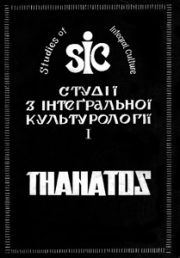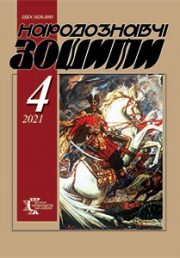The Ethnology Notebooks. 2025. № 5 (185), 1140—1152
UDK398.344:391.98 (477.8-89 Бой)
TO DRESS OUT LIKE A COW FOR ST. GEORGE’S DAY: RITUALS WITH WREATHS IN THE BOYKO’S TRADITION
SEREBRYAKOVA Olena
- ORCID ID: https://orcid.org/0000-0002-1039-2920
- Candidate of Historical Sciences (= Ph.D. in history),
- Senior researcher of the department of Modern Ethnology
- at the Ethnology Institute
- of the National Academy of Sciences of Ukraine,
- 15, Svobody Avenue, 79000, Lviv, Ukraine,
- Contacts: e-mail: o-sereb@ukr.net
Abstract. The aim of the article is to highlight the layer of customary and ritual, worldview phenomena associated with magic rites of household activities on the territory of Boyko’s region. The information obtained during field research on the territory of Boykivshchyna region is introduced into scientific circulation, systematized and analyzed.
The object of the research is the conventional worldview and customary-ritual culture of the residents of Boykivshchyna region; the subject is the archaic custom of decorating live-stock with wreaths, which existed among the Boykos during the spring and summer holidays. The ceremonial time, place and the performers of magic actions (cow, bull, calf, ox, shepherds, hostess, host etc.) are set. The local differences, interpretations, beliefs, custom instructions are characterized. The choice of plants for weaving wreaths, beliefs in their magic properties, ways of making and keeping ritual attributes are also worth attention. Examples of contact and verbal magic are given which represent details about the different stages of the custom. The existence of additional rituals for improving the quality of milk have been found. The actional level, semantics and peculiar motivations of the studied magic custom are revealed. The analysis shows that the ritual phenomenon had a protective and productive functions.
The basis of the article are the materials of the field research, local history essays, works of the end of the nineteenth and the beginning of the twenty-first centuries.
The methodology of this research is based on general scientific methodological principles and the basic requirements that apply to the works of historical and ethnological direction.
Keywords: Boykivshchyna, magic, wreaths, live-stock, ritual shepherd songs.
Received 20.08.2025
REFERENCES
- Franko, I. (Ed.). (1898). Folk beliefs in Pidhiria (systema tic index of topics with some additions). Etnohrafichnyj zbirnyk (Vol. V, pp. 76—98). Lviv [in Ukrainian].
- Zubryts’kyj, M. (1900). Folk calendar, folk customs and beliefs related to the days of the week and annual holidays (recorded in Mshanets of Staromiskiy county and neighbo ring villa ges). Materialy do ukrains’koi etnol’ogii (Vol. III, pp. 33—60).Lviv [in Ukrainian].
- Blyznak, I. (1937). Greenery-celebrational custom in the Boyko’s area — Shtukivets. Litopys Bojkivschyny, 9, 120—122 [in Ukrainian].
- Archival scientific collections of manuscripts and audio recordings of M.T. Rylsky Institute of Art Studies, Folklore and Ethnology of the National Academy of Sciences of Ukraine (hereinafter — ASCMA IASFE NASU). F. 14-3/1097. In. 4. Od. save 67. Arc. 1—68 [in Ukrainian].
- Archive of the Institute of Ethnology of the National Academy of Sciences of Ukraine (hereinafter —Archive of the IE NASU). F. 1. In. 2. Od. save 299. Arc. 1—83 [in Ukrainian].
- Archive of the IE NASU. F. 1. In. 2. Od. save 215. Arc. 1—98 [in Ukrainian].
- Archive of the IE NASU. F. 1. In. 2. Od. save 228. Arc. 1—53 [in Ukrainian].
- Archive of the IE NASU. F. 1. In. 2. Od. save 240. Arc. 1—65 [in Ukrainian].
- Archive of the IE NASU. F. 1. In. 2. Od. save 224 a. Arc. 42—52 [in Ukrainian].
- Archive of the IE NASU. F. 1. In. 2. Od. save 224 b. Arc. 1—79 [in Ukrainian].
- Archive of the IE NASU. F. 1. In. 2. Od. save 521. Arc. 1—46 [in Ukrainian].
- Archive of the IE NASU. F. 1. In. 2. Od. save 533. Arc. 1—183 [in Ukrainian].
- Skrypnyk, H. (Ed.). (2016). Ethnographic image of mo dern Ukraine. A corpus of expeditionary folklore and ethnographic materials. Calendar rituals (Vol. 6). NAS of Ukraine; M. Rylskyi IASFE. Kyiv [in Ukrainian].
- Archive of the IE NASU. F. 1. In. 2. Od. save 725. Arc. 1—157 [in Ukrainian].
- Archive of the IE NASU. F. 1. In. 2. Od. save 654. Arc. 1—132 [in Ukrainian].
- Archive of the Ivan Franko National University of Lviv. F. 119. In. 17. Od. save 209-E. Arc. 1—8 [in Ukrainian].
- ASCMA IASFE NASU. F. 28—3. Od. save 292. Arc. 1—11 [in Ukrainian].
- Il’nyts’kyj, M. (1983). My mountains, mountains, painted peaks. Recordings of folk songs from the village of Ilynyk in the Lviv region. Zhovten’, 6, 96—107 [in Ukra inian].
- Vasylechko, L. (1994). Palm Sunday. Folk customs, rituals and beliefs. Broshniv: Talia [in Ukrainian].
- Vasylechko, L. (2012). Palm Sunday. Folk customs, rituals and beliefs. Lviv: Tysa [in Ukrainian].
- Zborovs’kyj, P., & Sikora, L. (Ed.). (1998). Ritual shepherd songs in Turka region. Bojky. Drohobych [in Ukrainian].
- Schur, R. (2000). Pidgorodtsi: pages of history. Lviv [in Ukrainian].
- Sokil, H. (2004). Ukrainian circumambulation calendar-ritual songs: structure, functions, semantics. Lviv [in Ukrainian].
- Halajchuk, V. (2010). Traditional calendar customs and rites of the Starosambir region. Notes of the Shevchenko Scienti fic Society. Works of the ethnography and folklore section. Proceedings of the section of ethnography and folkloristics (Vol. CCLIX, pp. 138—178) [in Ukrainian].
- Pakholok, I. (2012). «May» («kletsannia») — the key attribute of the Green Holidays (Carpathian tradition). Fortress — the collection of the «Tustan» reserve (Book 2, pp. 574—582). Lviv [in Ukrainian].
- Hlavats’ka, L. (2011). Spring cattle-breeding customs and ri tuals of habitants from Boykivshchyna of the late 19 th — middle 20 th centuries. Calendar ritualism in the life of the ethnic group: Collection of scientific works. Materials of the international scientific conference «Odessa Ethnografic Reedings» (Pp. 81—89). Odesa [in Ukrainian].
- Hoschits’ka, T. (2019). The beliefs associated with trees in the spring-summer ritualism of Ukrainians from Carpathian region. Ethnology notebooks, 2 (146), 328—345 [in Ukrainian].
- Kyrchiv, R.F. (1985). Relics of St. George’s rituals in the Ukrainian Carpathians. Narodna tvorchist’ ta etnohrafiia, 2, 38—43 [in Ukrainian].
- Kyrchiv, R.F. (1988). Echoes of archaic rituals in the spring poetry of the Ukrainians of the Carpathians. Sovets’kaja etnohrafija, 2, 94—102 [in Ukrainian].
- Kyrchiv, R. (2002). Oral folklore of the Boykos. From the folklore regions of Ukraine. Essays and articles (Pp. 34—114). Lviv [in Ukrainian].
- Kyrchiv, R. (2002). From folklore archaic in the Boykivshchyna region. From the folklore regions of Ukraine. Essays and articles (Pp. 318—328). Lviv [in Ukrainian].
- Sokil, V. (2021). Boyko’s folk songs (Vol. 2, pp. 103—114). Lviv [in Ukrainian].
- Sokil, V. (2019). «Green mountains, don’t long for us». Folk songs from the village of Dovhe and the surrounding area recorded by Vasyl Sokol. Lviv [in Ukrainian].
- Bohatyrev, P.G. (2007). Magical actions, rituals and beliefs of Transcarpathia (Pp. 21—130). Moskva [in Russian].
- Hrom, H. (2002). Naguyevychi. Drohobych: Vidrodzhennia [in Ukrainian].
- Scientific Ethnographic Archive of the Faculty of History, Political Science and International Relations of the Vasyl Stefanyk Cis–Carpathian National University. F. 1. In. 2. Od. save 106 [in Ukrainian].
- Vinohradova, L.N, Tolstaja, S.M., & Tolstoj, N.I. (Ed.). (1995). Wreath. Slavic antiquities: an ethnolinguistic dictionary: in 5 vol. (Vol. 1, pp. 314—318). Moskva: Mezhdunarodnyje otnoshenija [in Russian].
- Fediaj M.Ye. (2010). The village on seven hills. History of the village of Isai, Turka district. Lviv: Kraj [in Ukrainian].
- Onyshkevych, M.J. (1984). Dictionary of Boyko’s dialects: in 2 parts. (Part 1). Kyiv [in Ukrainian].
- Vahylevych, I. (1978). Boykos, a Russian-Slavic people in Galicia. Zhovten’, 12, 117—129 [in Ukrainian].
- Boian, S. (2010). Spring-summer calendar rituals of the Boykos (late 19 th century — 1930 s) (Candidat dissertation: 07.00.05 — ethnology). Ivano-Frankivs’k [in Ukrainian].
- Fedun’, M. (2008). Customs of Galician Ukrainians in the pages of memoirs of the first half of the 20th century. Scientific journal of the National Polytechnic University named after M.P. Dragomanov. Historical Sciences: Collection of scientific works, 6 (Issue 6) [in Ukrainian].
- Onyshkevych, M.J. (1984). Dictionary of Boyko’s dialects: in 2 parts (Part 2). Kyiv [in Ukrainian].
- Sinokip, I.M. (Ed.). (1963). Ukrainian folk songs. Calendar and ritual lyrics. Kyiv [in Ukrainian].
- Vinohradova, L.N, Tolstaja, S.M., & Tolstoj, N.I. (Ed.). (1999). Ritual feeding. Slavic antiquities: an ethnolinguistic dictionary: in 5 vol. (Vol. 2, pp. 601—606). Moskva: Mezhdunarodnyje otnoshenija [in Russian].
- Ahapkina, T.A. (2002). Mythopoetic foundations of the Sla vic folk calendar. Spring-summer cycle. Moskva: Indrik [in Russian].







